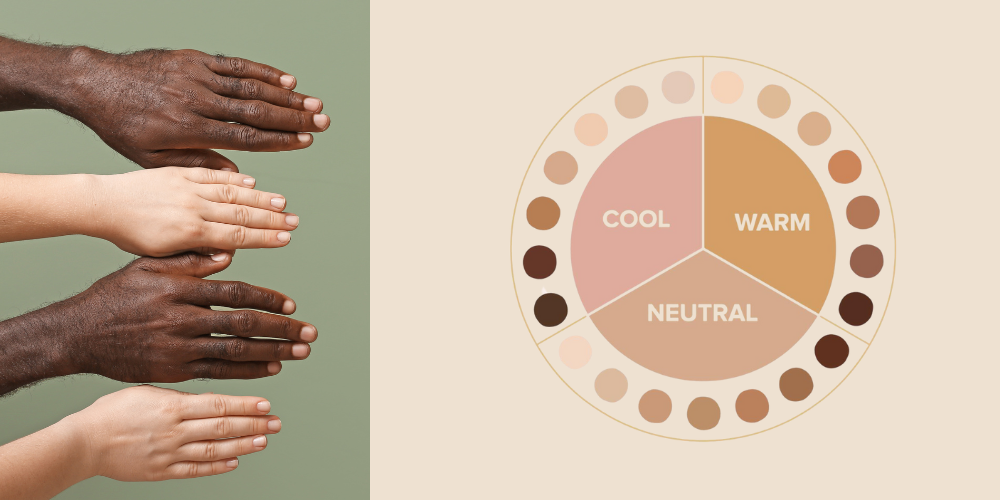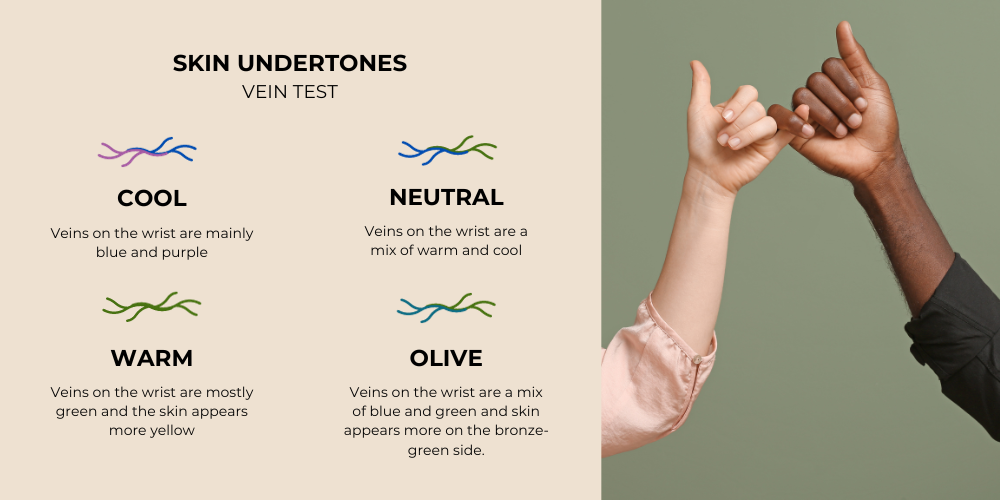
Are you tired of picking out clothes that just don't seem to flatter your complexion? Look no further than dressing for your skin tone! Determining your undertone and skin tone is the key to unlocking your most flattering and stylish wardrobe yet. In this post, we will guide you through the process of identifying your undertone and skin tone, with a quiz to make it even easier. We will also provide dressing tips for every season, so you can look fabulous all year round. And finally, we'll break down how to dress specifically for different shades of fair, tan, and dark skin tones. Get ready to feel confident and beautiful in every outfit!
The Secret to Looking Good: Dressing for Your Skin Tone
To elevate your look, it's essential to understand dressing for your skin tone's nuances - including undertones. Earthy hues such as olive or peach complement warm undertones, while navy or jewel-toned clothing fits cool skin tones. Neutral skin types can play with colours that work well with their natural complexion. Accessories can add an extra pop of colour but avoid anything that clashes with the base hue. Experimentation is key when finding what works best for your unique palette.

Determining Your Undertone
Identifying your skin tone and undertone is crucial when it comes to dressing for your complexion. Checking the colour of your veins is an easy way to determine whether you have cool or warm undertones. Blue or purple veins indicate a cool undertone, while green veins indicate a warm undertone. Trying on jewellery in different tones can also help identify your undertones - gold tones are best suited for warm-toned skin, while silver tones complement cooler skin tones better.
There are several hues that work well with different skin undertones. Warm-toned individuals should opt for earthy colours such as amber and beige, or pastel shades like peach and lavender. Cool-toned individuals look stunning in jewel tones like emerald and ruby, or blush and pink undertones. Neutral skin tones can experiment with both neutral colours like navy and greys, as well as bright colours like teal and jade green.

Knowing your skin tone is essential when selecting clothes that flatter you. You can determine whether you have a warm, cool, or neutral complexion by examining your veins or trying on different jewellery pieces. Yellow undertones indicate a warm skin tone, while pink undertones indicate a cool one. If you have a neutral skin tone, you have both warm and cool hues in your complexion.
To enhance warm undertones in your complexion choose earthy colours such as olive, beige or amber; jewel tones such as navy and emerald work well for cool-toned complexions; while pastel shades like lavender and peach pair nicely with both cool and warm-toned skin. With the right hue palette, dressing for your skin tone will be a breeze!
Dressing Tips for Every Season
When dressing for your skin tone, it's important to consider not only the colours you wear but also the season. Choosing fabrics that suit the weather is pivotal. Opt for breathable materials in summer and cozy ones in winter. Layering is another great way of adding seasonal pieces into your wardrobe. Lastly, don't forget about footwear - select shoes appropriate for the conditions you're dressing for.

Summer Tones
When it comes to dressing for your skin tone in the summer months, there are a few things to consider. Warm undertones are common during this time of year and often have golden or peach undertones. To complement these tones, try incorporating coral, turquoise or bright yellows into your wardrobe along with pastel shades for a softer look. It's best to avoid navy or grey hues during this time of year as they can clash with your complexion. One way to determine whether you have warm or cool undertones is by checking the veins on your wrist; green veins indicate a warmer undertone while blue veins indicate a cooler one. With these tips in mind and by experimenting with different shades that work best for your unique skin colour and tone like olive or beige hue you can create an Instagram-worthy summer wardrobe.

Autumn Tones
With autumn tones having a warm undertone, it's best to go for earthy hues such as deep greens, browns, oranges, and golds while dressing up for the season. To add warmth to your wardrobe, try incorporating wool, suede or leather pieces. Avoid colours that clash with your natural skin complexion or make you look pale. Opt for amber or beige shades to add warmth to your neutral skin tone. Jessica Alba and Lupita Nyong'o rock emerald green and ruby red this season respectively.

Winter Tones
When it comes to dressing for cooler skin tones in winter, the key is to choose the right hues and textures. Jewel tones like emerald, sapphire, and ruby are perfect for complementing the cool undertones of your skin. Neutral colours such as black, white, and grey can also be great options. Avoid warm yellows and oranges that clash with your cool undertones instead go for shades of blue or purple that will match your complexion perfectly. Experimenting with different shades is always a good idea when putting together your winter wardrobe.

Spring Tones
Spring is all about pastels and bright colours. When dressing for this season, it's important to consider your skin undertone and complexion. For warm-toned skin, go for peach and coral hues while cool-toned skin looks best in mint green or lilac. Neutral skin tones are versatile and can wear just about any shade, from lavender to jade green, so don't be afraid to experiment with different palettes. Stick to classic neutrals like beige or navy if you're unsure of what works best with your skin tone.

Neutral Tones
Neutral skin is versatile, allowing for a classic and timeless look that works for any occasion. Complemented by bold accessories or makeup, neutral wardrobe staples like beige, grey, or navy can be mixed effortlessly with other colours and patterns to create endless outfit possibilities. Experts recommend adding pastel shades like lavender or jade green to the mix or earthy amber hues if you have warm undertones in your complexion. Celebrities such as Kerry Washington or Jessica Alba often opt for cool-toned skin undertones with bright colours such as emerald or ruby red added to their wardrobe palette.
Dressing for Fair Skin
Colours that flatter your skin tone can make you stand out; this is especially true for those with fair skin. Pastels and jewel tones work best and can be paired with prints and accessories to add depth to outfits. Instead of wearing white or beige shades that can wash out fair skin, try pairing cool-toned pieces like jade green or emerald with warm hues like amber or caramel. For olive skin undertones, earthy tones, blush pink, and light teal work best. Celebrities like Jennifer Lopez and Cate Blanchett have figured out the secret to dressing well for their fair complexion by incorporating bright colours into their wardrobe.
Dressing for Medium Fair Skin
Dressing for medium fair skin requires careful consideration of your skin undertones. Opt for clothing colours that will complement your complexion, like jewel tones and pastels, while avoiding bright yellows and neons that can make your colouring look off. Experiment with various shades and patterns to find what works best for you. Don't forget to accessorize and use makeup that complements your skin tone to complete the look! Keep in mind Lupita Nyong'o's mastery of earth tones or Kerry Washington's love of amber hues for inspiration.
Dressing for Light Tan Skin
Knowing your skin tone is a game-changer when it comes to dressing stylishly and confidently. If you have a light tan complexion, complement it with warm hues like peach, coral, and gold while avoiding harsh pastels and cool blues. Experimenting with neutrals such as beige or brown is also vital in finding what works best for you. Accessories like jewellery and scarves in complementary colours can take your outfits up a notch. Don't forget to consider your undertones for an ideal wardrobe that complements every aspect of your complexion.
Dressing for Medium Tan Skin
Looking for ways to dress for your skin tone? If you're someone with a medium tan skin tone, understanding your undertones is key! Begin by identifying whether you have warm or cool tones, then opt for clothing colours that complement your complexion such as pastels alongside earthy hues like beige and caramel. Complement this with wardrobe staples like denim or even ruby reds to create an effortless daytime look! Remember to always try on clothes before making a purchase.
Dressing for Dark Tan Skin
Earth tones like amber and caramel work well with this skin tone, as do jewel tones like ruby and emerald. Metallics such as platinum can also be a great choice. Avoid pastels and neon hues that will clash with your cool-toned skin. Experiment with different shades of warm undertones like peach and navy blue to find what works best for you. Patterns like jade green or floral prints can also enhance the richness of your complexion. Accessorize with jewellery in blush or pink undertones, or add a scarf in lavender or teal to add interest and dimension to your outfit.
Dressing for Dark Skin
When it comes to dressing for your skin tone, understanding your undertone is crucial. For cool-toned dark skin, go for jewel tones and earthy hues like olive or navy. On the other hand, warm-toned dark skin looks great in pastel shades like peach or beige. Don't be afraid to experiment with prints and patterns like floral or stripes! Accessorize with amber jewellery or a teal scarf to add some interest to your outfit. Overall, dressing for dark skin is all about finding the right colours that complement your complexion.

Your skin tone is a vital factor that affects how you look in certain colours and styles of clothing. Determining your undertone can help you choose the perfect shades for your wardrobe. Whether you have fair skin or dark tan skin, knowing your skin tone can make all the difference in how you present yourself. Dressing for every season becomes easier when you know what colours look best on you. Take our quiz to find out your skin tone and read our guide to learn how to dress for it. With this knowledge, you'll be able to create a wardrobe that flatters and complements your unique complexion.













